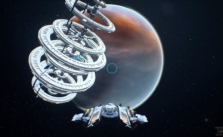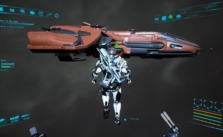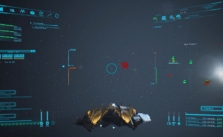SpaceBourne 2: How to Travel Within and Between Star Systems

Space Travel in SpaceBourne 2: Warp, Star Gates, and Planets Exploration
Our comprehensive SpaceBourne 2 space travel guide will have you cruising the cosmos like a pro in no time. We’ll take a deep dive into Local Warp, Interstellar Warp, Star Gates and planetary exploration, by the end of this guide, you’ll be a master of navigating the game’s expansive universe and enjoying all its features!
Local Warp Travel
Accessing the Scanner screen
- Press T or click the button in the top-left menu to open the Scanner screen. This screen serves as a map of your current star system, enabling you to navigate and set warp destinations.
- Get acquainted with the interface and controls for panning, zooming, and rotating the view, as these will be crucial for effective navigation.
Executing a Direct Warp
- Press B to activate your Warp Drive. This action will display all possible destinations within the star system, including other stars, planets, and points of interest.
- To choose a Warp Target, aim the ship at the desired location and press the Middle Mouse Button. The ship will align with the target and plot the route.
- Once the route is plotted, charge the Warp Drive by tapping SHIFT once. The ship will then initiate warp travel to the chosen destination.
- To cancel warp travel before it starts, press B (Note: You cannot cancel warp travel once it begins). This option is handy if you need to change your destination or react to an unexpected threat.
Planetary Exploration:
Warping to a Planet
- Press B to activate your Warp Drive and follow the steps for executing a Direct Warp to travel to a planet within the star system.
- Upon arriving at the planet, you’ll automatically enter its orbit. Press B again to activate the Warp Drive and unveil surface locations for exploration.
- Various surface locations may be visible, but some concealed or secret locations will necessitate further investigation on foot or using the hover bike. These sites can offer exclusive rewards & challenges.
Scanner Screen
Controls
- Hold Left Click to rotate the view. This action lets you gain a better perspective on the star system and pinpoint points of interest.
- Hold Right Click to pan the view, assisting you in navigating the map and concentrating on particular areas.
- Use the Mouse Wheel to zoom in and out offering a wider or more detailed view of the star system as needed.
- Press Left Shift to accelerate camera movement making navigation quicker and more efficient.
Setting Warp Targets
To set a Warp Target from the Scanner screen, left-click the desired location (e.g., Star Gate) within the star system.
After selecting the Warp Target, the Warp Drive will activate. Close the screen, point the ship towards the target, lock onto it, and charge the Warp Drive to start the journey.
Interstellar Travel
Accessing the Galaxy Atlas
- Press M or click the button in the top-left menu to open the Galaxy Atlas. This map offers an overview of the entire galaxy, enabling you to plan interstellar trips and explore new star systems.
- Get familiar with the interface and controls, which resemble the Scanner screen but with extra tools and features.
Navigating the Galaxy Atlas
Use the same controls as the Scanner screen for panning, zooming, and rotating the view.
Make the most of the three handy camera buttons on the upper-right for easy navigation:
a. The first button hones in on your present location, offering an in-depth view of your immediate environment.
b. Second button provides a bird’s-eye view of the galaxy presenting a wide-ranging perspective of the entire map.
c. The third button focuses on your current sector, assisting you in pinpointing areas of interest within a particular region of the galaxy.
Galaxy Atlas Tools
Take advantage of the Search Engine tool to locate specific systems by entering their name or ID. This feature enables you to swiftly find star systems for missions, trade, or exploration. Employ the Route Setter to establish a Warp Route to a target system by inputting its Name or ID and hitting the button.
This generates an optimized path for interstellar travel, guiding you through multiple Star Gates as required. Make use of the Bookmarks screen for easy access to frequently visited systems. This allows you to rapidly navigate to crucial locations for trading, mission completion, or ship customization. Personalize the Settings window to display or conceal extra information on the Map. This enables you to adjust the map display according to your individual preferences and requirements.
Setting Warp Routes
Create a route to a system using the Galaxy Atlas tools, which will direct you through the necessary Star Gates and waypoints. If you have a mission, hit J to open the Mission Log and click on the Set Route button. This automatically sets a route to your mission destination, saving you time & energy.
Interstellar Travel via Star Gates
With your route established, make your way to the local Star Gate in your current star system. Utilize the Signals Interface to request a jump to the next route when you’re close to the Star Gate. This initiates the interstellar travel process.
Travel will occur automatically, jumping through waypoints sequentially. Your ship will be scanned at each waypoint, which may affect your progress if you have a criminal record, bad reputation, or negative faction relations.
Direct Interstellar Travel
Direct Travel to another star:
- Follow the same steps as in Local Warp, but brace yourself for extended distances & travel durations.
- Once beyond the local gravity field, the ship will attain faster warp speeds, allowing for swifter travel between stars.
- Direct Travel can serve as a speedy way to dodge perilous situations or circumvent Star Gates when needed.
Conclusion
With this thorough guide, you ought to have a profound understanding of SpaceBourne 2’s space travel mechanics. As you traverse the vast galaxy, remember to employ the various tools & features at your disposal for efficient navigation and travel.
SpaceBourne 2 Ultimate Beginner’s Guide: Tips and Tricks for New Space Pilots










